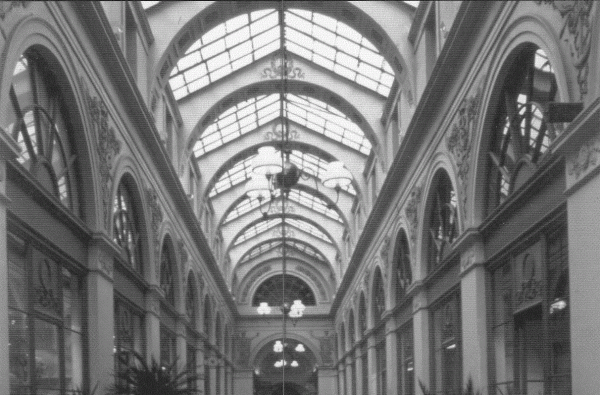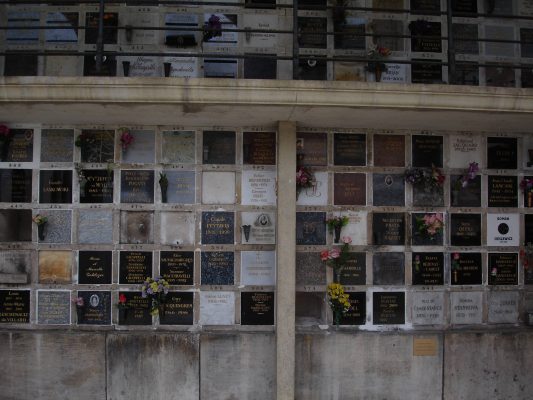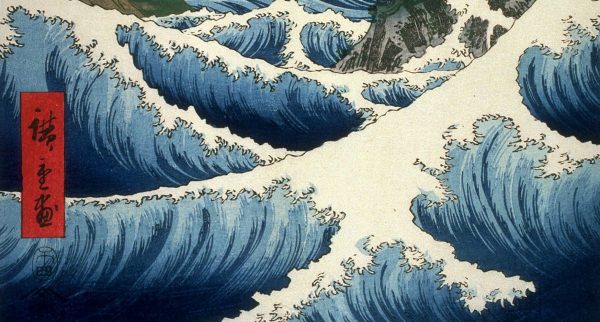There are some who claim that ‘good’ literature is actually untranslatable. Before I could read German, I found this thought comforting because I was completely unable to appreciate German literature, particularly the literature of the postwar period. I thought I should just learn German and read these works in the original and then my problem with German literature would evaporate of its own accord.
There were exceptions, though, such as the poems of Paul Celan, which I found utterly fascinating even in Japanese translation. From time to time it occurred to me to wonder whether his poems might not be lacking in quality since they were translatable. When I ask about a work’s ‘translatability,’ I don’t mean whether a perfect copy of a poem can exist in a foreign language, but whether its translation can itself be a work of literature. Besides, it would be insufficient if I were to say that Celan’s poems were translatable. Rather, I had the feeling that they were peering into Japanese.
After I had learned to read German literature in the original, I realised that my impression hadn’t been illusory. I was occupied even more than before by the question of why Celan’s poems were able to reach another world that lay outside the German language. There must be a chasm between languages into which all words tumble.
One possible answer to my question came to me later in a surprising way. One day Klaus-Rüdiger Wöhrmann called me to thank me for the photocopy he had asked me to make for him. This was a copy of the Japanese translation of Celan’s book of poems Von Schwelle zu Schwelle [‘From Threshold to Threshold’]. The translator of the volume was Mitsuo Iiyoshi, through whose Japanese version I had made the acquaintance of Celan’s text. When Wöhrmann said to me that the radical 門 [‘tor’ in German, ‘gate’ or ‘gateway’ in English] played a decisive role in this translation, an idea flashed through my head: It was precisely this radical that embodied the ‘translatability’ of Celan’s literature.
A radical is something like the ‘main component’ of an ideogram [an ideogram being a written sign that expresses an entire concept rather than a sound like a letter of the alphabet]. There are also ideograms that consist only of a radical, for example gate 門, but most of them have additional components. All the characters that contain the radical gate have something to do with the concept gate on a semantic level. To be sure, the meaning of the radical and the ideogram as a whole are sometimes so far removed from one another that the connection can’t be recognised without the help of the dictionary. And when you’re reading, you don’t think about the meaning of the individual components of each character but instead grasp the entire sign as a unit. For this reason, it would never have occurred to me to think about the role of a radical in Celan’s work. Only the clear gaze coming from the outside could draw my attention to this.
But how is it possible that in this thin volume of poems, ideograms using the radical gate keep turning up at all the most crucial junctures? It cannot be a coincidence, for coincidences might exist in literature, but not in a reading of a literary work. Asking about the author’s intention is no help to us at all: It isn’t possible that Celan secretly learned Japanese and intentionally wrote in such a way that in the Japanese translation the radical gate would become a key sign.
The radical gate shows up twice in the title of the volume Von Schwelle zu Schwelle [‘From Threshold to Threshold’]. The character 閾 [‘schwelle’ or ‘threshold’] contains the radical gate. In this case it isn’t difficult to guess at the common ground between the meaning of the radical and that of the sign as a whole: Both cases involve a border. But this title already shows that a crossing of borders is not intended: It isn’t a matter of crossing one particular border but rather of wandering from one border to another.
In the first poem in the book, yet another ideogram containing the radical gate appears: to hear 聞. Ich Hörte Sagen [‘I Heard It Said’] is the title of this poem, which begins with the sentence:
Ich hörte sagen, es sei
im Wasser ein Stein und ein Kreis
und über dem Wasser ein Wort,
das den Kreis um den Stein legt.
I heard it said there was
a stone in the water and a circle
and above the water a word
that placed the circle around the stone.
In the sign to hear 聞, you see an ear 耳 beneath the gate 門. According to this sign, to hear means to stand on the threshold like an ear. In the next stanza the ‘I’ sees another figure that doesn’t remain standing on the threshold but strides across it:
Ich sah meine Pappel hinabgehn zum Wasser,
ich sah, wie ihr Arm hinuntergriff in die Tiefe,
ich sah ihre Wurzeln gen Himmel um Nacht flehn.
I saw my poplar go down to the water
I saw how its arm reached down into the depths
I saw its roots pleading skywards for night.
The world beneath the water is behind the threshold. The ‘I’ in the poem sees how the ‘poplar’ dips down into the unfamiliar world of the water, but the ‘I’ remains an observer and doesn’t hurry after it.
Ich eilt ihr nicht nach,
ich las nur vom Boden auf jene Krume,
die deines Auges Gestalt hat und Adel,
ich nahm dir die Kette der Sprüche vom Hals
und säumte mit ihr den Tisch, wo die Krume nun lag.
I didn’t hurry after it,
I merely gathered from the ground the crumb
that has the shape of your eye and nobility
I took the chain made of proverbs from your neck
and draped it about the table where the crumb now lay.
The ‘I’ doesn’t descend into the water but rather remains on the threshold pursuing a magical game: The stone and the circle are copied with the help of the ‘crumb’ and the ‘chain’ and so the image said to be visible beneath the water is repeated upon the table.
This magical game has the effect of a process of translation. The translator copies the image that exists beneath the water on the desk. The poplar, on the other hand, is not a translator. Its body disappears in the water.
If one were to equate the unfamiliar world beneath the water with the realm of the dead, then the magical game would be a translation of the language of the dead into writing. The translator hears the word of the dead and reads it [does he gather it up – auflesen – like ears of grain from the ground or read it – lesen – like a written character?] and places it upon the desk, i.e. he writes. The poplar on the other hand does not write. It vanishes beneath the water like a dying woman: Und sah meine Pappel nicht mehr [‘And did not see my poplar again’].
Hearing plays an important role throughout the first series of poems in this book, which is entitled Sieben Rosen Spater [‘Seven Roses Later’]. To me it appeared as if all these poems were reminding me that hearing cannot be thought of separately from a threshold. This is something I had known back when I was living exclusively within the Japanese language. The ideogram to hear 聞 captured this knowledge without my being conscious of it. There is a saying that perhaps also belongs to this knowledge. It goes: Monzen no kozoo narawanu kyoo o yomu [‘The boy who lives before the gate of a temple can recite the prayer without learning it’]. For me, the boy who doesn’t go into the temple and remains standing at the gate embodied the person who is hearing. But now that I have begun to think in German quite frequently, I most often associate the verb to hear [‘hören’] with to belong to [‘zugehören’] so that when I hear something I feel the need to hurry after the unfamiliar voice and not remain standing on the threshold.
The more intensely I read, the stronger my impression became that Celan’s poems were peering into the Japanese. The poet must have sensed the gaze of the translation being cast from the future upon the original text. Interestingly, it isn’t possible to account for Celan’s ability to perceive this gaze by citing his knowledge of the foreign language. There must be an ability to summon up one or several foreign systems of thought during the writing process that lie outside the particular language being used [in this case the system of Chinese ideograms such as it is preserved today in, for example, the Japanese language] and to make their presence felt in the text.
The title of the third poem, Leuchten [‘Gleam’] contains the ideogram gleam 閃, which also includes the radical gate. Here we see a man 人 standing beneath a gate 門. I had never stopped to think how it could be that the combination of a gate and a human being could produce a gleam or glow. Perhaps someone who stands beneath a gate [or on a threshold] will be particularly receptive to a gleam from an invisible world. [This idea was confirmed as I continued to read.]
In addition I sensed something that strongly linked the German word leuchten [‘gleam’] with this ideogram: It struck me that the word ich [‘I’] briefly appears in the middle of the German word leuchten when you speak it aloud clearly. The word ich does not otherwise appear in this poem, there is only mir [‘to me’], du [‘you’] and uns [‘to us’]. Only in this gleaming does the ‘I’ appear in a quick flash, for one brief, fragmented moment.
If I imagine a poem as a receptor for rays of light, it becomes meaningless to look for something ‘typically German’ in a German poem. For what it picks up is always foreign to it and never the poem itself. Perhaps there are also German poems that have been made of German soil. But the poems that most interest me are the ones that correspond to constellations of foreign languages and ways of thinking that they had not previously encountered at the time of their composition. I am describing foreign systems of thought here as constellations because every sign within them is like a star casting its light on the original. When you read the poem Strähne [‘Strands’], you can imagine that while the poet’s mouth might consist of earth, his words cannot. This mouth senses the starlight and speaks the words that differ from the familiar language.
Niedergehn hier die Fernen,
und du,
ein flockiger Haarstern,
schneist hier herab
und rührst an den erdigen Mund.
Going down here the distant ones,
and you,
flake-like, a hairy star
are snowing down here
and touching the earthen mouth.
The ray from the star is not yet visible here. Not until the translator comes to give the ray a form does it finally become visible. But how can this process be understood temporally? What is the time supposed to look like in which the translation can cast its rays upon the original? In the first line of the fifth poem Mit Äxten Spielend [‘Playing With Axes’], the word stunden [‘hours’] appears, the translation of which again uses an ideogram containing the radical gate. The word hour 時間 is put together using time 時 and in-between space 間. In the second sign 間, one sees the sun 日 beneath a gate. In the earlier form of this sign, it was the moon and not the sun beneath the gate. The moonlight shines through the crack of the slightly open gate: That’s how people imagined an in-between space at that time.
Sieben Stunden der Nacht, sieben Jahre des Wachens:
mit Äxten spielend,
liegst du im Schatten aufgerichteter Leichen
–o Bäume, die du nicht fällst! –,
zu Häupten den Prunk des Verschwiegenen,
den Bettel der Worte zu Füßen,
liegst du und spielst mit den Äxten –
und endlich blinkst du wie sie.
Seven hours of night, seven years of waking:
playing with axes,
you lie in the shadow of propped-up corpses
–o trees that you do not fell!,–
at your head the pageantry of the unspoken,
at your feet the beggary of words,
you lie there, playing with the axes–
and at last you are shiny like them.
This ‘you’ is as shiny as the axes, that is to say it probably doesn’t emit rays of its own but rather is ‘at last’ receiving a light from without that makes it shine. This ‘you’ can be a poem that has waited for some time for the light of translation. This poem lies like a bridge between the ‘pageantry of the unspoken’ and the ‘beggary of words.’ In this way, the poem is an in-between space. A similar space upon a threshold also appears in the poem Gemeinsam [‘In Common’]:
Da nun die Nacht und die Stunde,
so auf den Schwellen nennt,
die eingehn und ausgehn,
Since now the night and the hour
there upon the threshold names those
who go in and go out,
The original’s encounter with its translation takes place during the composition of the text and not later. This can only be understood if one imagines this composition not as a single point on a continuous timeline but rather as existing in an in-between space on a threshold. The in-between space isn’t a closed-off room, it’s the space beneath a gate.
I began to look at Celan’s poems as gateways rather than as buildings in which meaning might be stored like a possession. Thinking of this, a passage occurred to me from Gerschom Scholem’s Religiöse Autorität und Mystik [‘Religious Authority and Mysticism’]: The genius of mystical exegeses resides in the uncanny precision with which they derive their transformation of Scripture into a corpus symbolicum from the exact words of the text. The literal meaning is preserved but merely as the gate through which the mystic passes, a gate, however, which he opens up to himself over and over again.
Celan’s words are not containers, they are openings. I go through the opening in the gate each time I read them. The ideogram to open 開 appears in this book as well, in the crucial last line of the poem Ein Körnchen Sands [‘A Grain of Sand’]:
und ich schweb dir voraus als ein Blatt,
das weiß, wo die Tore sich auftun.
and I waft before you, a leaf
that knows where the gates will open
Writing a word means opening a gate. To read the characters is to read the words, not the sentences or the sound. The fascinating translatability of Celan’s poems may well lie in part in their literalness. Celan himself often speaks of the word for example in the first poem:
und über dem Wasser ein Wort,
and above the water a word,
or in Strähne [‘Strands’]:
Dies ist ein Wort, das neben den Worten einherging,
ein Wort nach dem Bilde des Schweigens,
umbuscht von Singrün und Kummer.
This is a word that walked beside the words,
a word after the image of silence,
hedged-in with creeping myrtle and worry.
In this poem, the word [‘wort’] is clearly differentiated from language or speech [‘sprache’]: the word imitates silence, while language injures the body of the poet:
ein Wort, das mich mied,
als die Lippe mir blutet’ vor Sprache
a word that avoided me
when my lip was bloody with speech
I compare Celan’s words with the gates and remember that Benjamin describes literalness in a translation as an ‘arcade’: True translation is translucent; it does not conceal the original, does not block the light from falling upon it, but allows pure language–as if intensified though its own medium–to shine upon the original all the more fully. This may be achieved, above all, by a literal rendering of the syntax, which proves the word rather than the sentence to be the primary element [Urelement] of the translator. For the sentence is the wall before the language of the original, and literalness is the arcade. An arcade consists, if you will, of many gates placed one behind the other. If each one of Celan’s words comprises a gate, the poem as a whole might resemble an arcade.
Now I will pass through the final gate in Sieben Rosen Später [‘Seven Roses Later’]: The seventh character with the radical gate: 闇 [‘dunkel’ or ‘darkness’] appears in two of the poems, in Von Dunkel Zu Dunkel [‘From Darkness to Darkness’] and Der Gast [‘The Guest’]. In terms of its composition, this is a particularly mysterious sign, for here a sound 音 is standing beneath the gate 門 and is supposed to signify darkness. I read Celan’s poem Von Dunkel Zu Dunkel [‘From Darkness to Darkness’] as if it contained a clue to the composition of this sign:
Du schlugst die Augen auf – ich seh mein Dunkel leben.
Ich seh ihm auf den Grund:
auch da ists mein und lebt.
Setzt solches über? Und erwacht dabei?
Wes Licht folgt auf dem Fuß mir,
daß sich ein Ferge fand?
You opened your eyes – I saw my darkness live.
I see through it down to the bed;
there too it is mine and lives.
Is that a ferry? Which, crossing, awakens?
Whose light can it be at my heels
for a boatman to appear?
After reading this poem, I explain to myself the puzzling character 闇 as follows: That which can no longer be represented by language, the darkness, presumably lies behind the gate, but it isn’t possible to peer through this gate because a sound is standing in the way [i.e. directly beneath the gate]. At the same time, there is a fear that it would be impossible to gain access to the darkness at all if this sound were no longer to exist. The sound is blocking the gate, but it is also the medium connecting this side of the gate with the other side. One must hear it, then it will no longer impede one’s vision.
The poem Von Dunkel Zu Dunkel [‘From Darkness to Darkness’] – above all the question: Setzt solches über? [‘Is that a ferry?’ or ‘Does such a thing cross over?’ ‘Does it translate?’] – invites me to think a bit more about the composition of a poem and its translation. In the first stanza, a translation that doesn’t yet exist looks at the poet [‘You opened your eyes’], and he senses the darkness within himself. With this, the poem is set in motion. The second stanza is about the search for a translation. The question asked is whether such a thing [darkness] can be carried over [translated] at all, and whether this would cause it to awaken. It’s lovely to imagine something awakening through its own translation. Until the translator [the boatman] can be found, the author stands there disoriented, lonesome and uncertain. He asks himself: ‘Whose light can it be at my heels for a boatman to appear?’
It’s lovely that it remains open when the working process of writing begins and when it is completed. Perhaps this process will continue until the poem has been translated into the last language.
In any case, it’s a miracle that Celan was able to write Sieben Rosen Später [‘Seven Roses Later’] without the help of a dictionary of Chinese characters. There are exactly seven different ideograms containing the radical gate that are used in the translation: threshold 閾, gate 門, to hear 聞, to open 開, in-between space 間, to gleam 閃, darkness 闇. This corresponds to the seven roses or the seven hours–the magical number referred to again and again. The seven roses express a period of time, as one can see in the expression: seven roses later. While you are reading, each rose opens like an ideogram, like a gate or like an in-between space.
The radical gate is the visible element in this translation that shows us why the translation is effective as literature. The translation is not the image of the original but rather, in the translation a meaning of the original is given a new body [a written body, in this case, not one for sound to resonate in]. Walter Benjamin writes: Translatability is an essential quality of certain works, which is not to say that it is essential that they be translated; it means rather than a specific significance inherent in the original manifests itself in its translatability.
Translator’s note: The translations of Celan used here are my own, with the exception of the poem From Darkness to Darkness, which was translated by Michael Hamburger. The translations of Walter Benjamin are by Harry Zohn [lightly edited by me], and those of Gerschom Scholem are by Ralph Manheim.
share
ABOUT THE CONTRIBUTOR
Susan Bernofsky, co-chair of the PEN Translation Committee, is the translator of six books by the Swiss-German modernist author Robert Walser as well as novels by Jenny Erpenbeck, Yoko Tawada, Hermann Hesse, Gregor von Rezzori and others.




